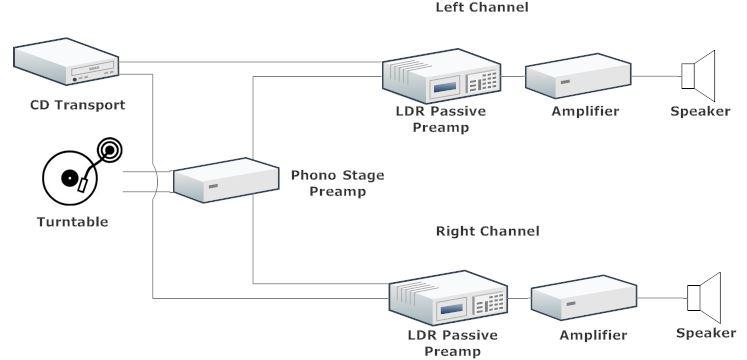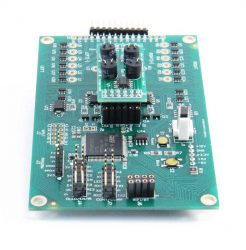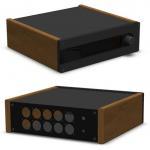Tortuga Audio Goes To Harvard With Dual Mono Preamps
The best part of being in the high value audio design and manufacturing business is working with customers who have more interesting ideas than you do.
A recent example is when a full professor at Harvard University contacted us and asked if we could provide a pair of mono passive preamplifiers for his home audio rig.
Dual Mono Preamps?
Yes, mono preamps.
As in a two single channel LDR passive preamps each located immediately upstream of a pair of mono tube amps as shown in the diagram below.
He wanted each passive preamp located physically adjacent to its respective power amp thus eliminating any potential RC filtering effects from long (or high capacitance) downstream interconnects. Plus he wanted it all to work seamlessly with a single remote.
Could we do it?
With two discrete passive preamps separated by up to 10 feet or more, the challenge was twofold.
Matching LDR Performance
Despite their superior sonic performance, working with LDRs is inherently challenging because the relationship of LED control current vs. resistance can vary considerably from one LDR to the next.
Fortunately, precision matching of LDR’s is the hallmark of Tortuga Audio’s technology. Usually we match four LDRs in each unit through a two stage testing protocol combined with software driven precision microprocessor control.
With two preamps running in parallel, we needed to extend our LDR performance matching beyond just a single preamp to ensure identical attenuation schedules in both passive preamps.
Even though they would be operated in mono mode (using just one side – left or right – of each unit), the LDR6 Passive Preamps are stereo units. So we would have to match performance with 4 channels using 8 LDRs.
Synchronizing Volume Control
Secondly, both units needed to operate synchronously in response to volume control and other commands (raise/lower/mute etc.) from a single remote. And in the the event the two preamps somehow became out of sync, there had to be a simple and effective way to get them back in sync.
Testing Testing 123
After modifying our testing tools to match 8 rather than just 4 LDRs, we built two perfectly matched stereo LDR6 Passive Preamplifiers with identical software and hardware.
Of course Murphy was ever so helpful when he burned out our data acquisition unit in the middle of all this and we had to wait a week for the replacement unit to arrive.
Then it was time to put it to the test.
Two stereo LDR6 Passive Preamplifiers were located about 8 feet apart with each hooked up to a monoblock power amp. Although each preamp is a stereo (left/right channel) unit, we only used one channel in each preamp thus effectively using them in mono mode.
Using a single IR Remote, we turned the units on with the 12V trigger outs of each unit turning on their respective power amp.
Since both units are programmed to start at the same nominal volume level they were already in sync upon powering up.
We fired up some music and proceeded to ramp the volume up and down using the single handheld IR Remote controller.
Test Results
In a word – success!
Control via a single IR Remote was robust. With the precision of a 16 megahertz microprocessor and a high performance IR receiver, both units operated in lockstep in response to volume control changes and other commands such as mute, balance adjustment and input change.
When we deliberately tampered with the volume balance by manually increasing the volume on one side via the encoder knob at the preamp, we were easily able to re-sync the units by lowering the volume (via the remote) until both units were at zero volume (muted) as indicated by the blinking status LED on each unit. As the volume was raised back up to normal listening levels, both sides stayed in sync.
And maybe it was our imagination, but sonically, there seemed to be something special happening. The stereo imaging and soundstage were better than ever.
Now it was time to ship these units to Harvard and wait for the professor to grade our work.
Report Card
High praise from the professor…
Got them home, fired everything up, and they worked like a charm — perfect, just at advertised. After a while (while the tube stuff was warming) they sounded great, better than I had thought. Separation is amazing, as is “sound stage”, at least with current MC cartridge and phono section, as hoped. They are a “keeper”
A week or so later, an update….
Still loving them, in fact they [seem] to be “improving” in very subtle ways.
Dual mono is certainly superior for some reason (I think that you mentioned it too when you started to play with the control features) — no contamination of cross channel signals.







